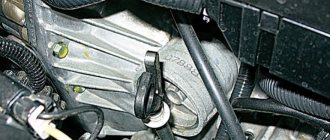- home
- car transmission
- …
As I wrote in a previous article about frequent automatic transmission breakdowns , one of the reasons for incorrect operation may be an incorrect oil level. There is simply more of it (high) or less (low). In both cases, the machine will behave inappropriately. Today I suggest you talk about the low level (we’ll look at it in detail). But when there is more of it, there will be a separate article. As usual there will be a text version + video below...
Very often, a low level is due to breakdowns, for example, the automatic transmission pan has been punctured or some kind of gasket has leaked (although they may not be filled enough). This is because not all automatic transmissions are the same, some models require strong warming up, others almost when cold, this can cause confusion
Why is level so important?
You need to understand that ATF is the fluid in an automatic transmission , it is a working fluid (essentially like a gear), and it must have a certain value. No more, no less.
In extreme cases, malfunctions will appear, which in the future will lead to really serious breakdowns. And repairing a machine, to put it mildly, is not cheap.
Moreover, changing the oil on old automatic transmissions and on new ones is slightly different, if only because the old ones had a dipstick (as well as a filler plug), but the new ones often don’t have one, there is only an inspection window.
Features of competently checking the amount of lubricant in system automatic transmissions on various machines
- Audi. Most of the existing automatic transmissions in Audi cars come without dipsticks.
- BMW. By the way, automatic BMW cars also come without a dipstick, so checking the amount of lubricant is carried out through a similar inspection window.
- Honda - the nuance here is that on some car models of this brand, the amount of lubricant is checked with the engine turned off.
- Hyundai. The lever for rotating the selector on an automatic transmission should not be set to the “P” value, but rather to the “N” value.
- Jeep. The same. The lever for rotating the selector on an automatic transmission should be set not to the “P” value, but to the “neutral” value.
- Mazda. The selector lever on an automatic transmission should be set not to the “P” value, but to the “N” value.
- Volkswagen. Most automatic transmission systems in Volkswagen cars do not have special ones, and instead there is a viewing window in the box. True, here too the selector lever on the automatic transmission should be set not to the “P” value, but to the “N” value.
Reasons for a drop in automatic transmission oil level
There are many reasons, both external and internal. Let's start with the most difficult thing and specifically about hidden reasons
- Vacuum corrector . Installed on old Mercedes cars, less often FORD and NISSAN. This is a complex structure, but if we just talk about work. It was connected to the engine intake manifold by a pipe; between them there was a membrane, which seemed to sense the vacuum during supply and correct the operation of the automatic transmission, for example, shifting or kickdown.
BUT it happened that the membrane broke, and oil from the automatic transmission got into the intake manifold, and then into the engine. The level in the internal combustion engine was constantly rising, but in the automatic transmission it was falling. Due to the high volume, the engine began to smoke blue smoke , as if there was oil consumption in the engine. BUT if you check the dipstick in the automatic transmission, the level there constantly drops
- Torque converter oil seal . IT seems to lock the oil in the automatic transmission to the “donut”, it should not leak, but sometimes this happens. You can understand this right away; there will be a puddle of red liquid under the car. Moreover, the leak will be in the place where the automatic transmission and engine are mounted.
- The pan or gasket has broken . It often happens when they hit a bump or a stone. Moreover, now on modern automatic transmissions, the pan can be made of plastic; breaking through it can be easy and simple. Also, at the service station, you may install the pan incorrectly after replacing the filter, or install an old gasket, which will also cause a leak.
- A hose or radiator has broken, the clamp has become loose. This is the cooling system of the machine, the reason here is a break in the hoses (perhaps the clamps are loose or not tightened). Sometimes the radiator itself breaks through
- Incorrect replacement at service station . The machines are not the same, sometimes you need to heat the oil and then set the level, but many do not do this, but change it to a cold one. Because of this, the level is not correct, especially in an automatic transmission with a control window.
When is it necessary to change?
If a motorist has decided that his car should have its transmission oil changed, he must make sure that his desire is correct. Renault Megane developers do not indicate in the car’s operating instructions the timing according to which the automatic transmission fluid should be changed. It is quite difficult to decide on clear regulations, especially since the concern assures that there is no such need, guaranteeing almost eternal normal functionality of the unit.
In practice, experts note the fact that the Renault Megane 2, like many other vehicles of French origin, is somewhat not adapted to the harsh Russian realities; due to the quality of the road surface, the constant increase in transmission temperature and operation in difficult mode, the gearbox comes into operation much faster disrepair
It is important to understand that you should try to prevent the problem, check the condition of the lubricant and, if its level decreases, add the missing fluid to the structure. Although in fact, experts say that if the need arises to add oil to the transmission, it is advisable to buy a new substance and completely replace all the working material without mixing old and new oils
How to properly check the oil in an automatic transmission?
It is worth remembering that now there are, as it were, two types of machines, these are conventionally old - there is a probe, and conditionally new ones (often this probe simply does not exist) are checked through the control window. For example, a box from KIA - A6LF2, has only an inspection window.
Once again I would like to remind you that on some cars the oil level in the automatic transmission is checked when it is hot, for example at + 70 degrees. On others, they check almost cold, then at + 30. For a correct replacement, you need to refer to the manual of your particular transmission
How to check in the version with a probe
This is the simplest procedure, but again, on modern machines this is often not the case:
- Warming up the automatic transmission, you need to drive a few kilometers
- We place it on a flat surface - this is mandatory (there should be no slope)
- We turn off the internal combustion engine
- We take out the dipstick of the machine, wipe it and put it back in place (this makes for a more accurate level)
- Usually there is a HOT mark on the dipstick (that is, hot), the oil should be within
- If there is more of it, be sure to throw it off, you can pump it out through the dipstick tube with a syringe
- If there is less, just add
How to check if there is no dipstick
This means you have a modern unit, for some reason manufacturers began to abandon the probe:
- Warm up the transmission again
- We drive into a pit or take it up on a lift
- Looking for a control hole
- Do not turn off the engine, take a container for oil (by the way, you need to be careful, it will be hot)
- We unscrew the plug. If the oil poured out, it means there was more of it. If not, then the level is low and needs to be added.
- Take a syringe and add until it flows out of the control window
Just a few drops are enough to pour out of the control hole.
How much lubrication is required
For automatic transmissions, or simply automatic transmissions, a special transmission fluid is provided. It has a special marking, and the easiest way to recognize it is by the ATF inscription on the packaging.
To find out exactly how much oil should be in the box, you should look at the instruction manual.
The manufacturer sets individual standards for the oil level in each type of automatic transmission.
The required amount of fresh fluid also largely depends on what replacement method is used. For example, during a partial replacement, not the full volume of the automatic transmission crankcase is drained. If the box is designed for 6 liters, and the replacement is carried out using a partial method, filling all 6 liters is pointless. Usually, when updating, you can drain about 3 liters.
When replacing yourself, it is recommended to always fill in the same amount of ATF lubricant that was previously drained. Therefore, when updating the lubricant, it is worth taking a measuring container, determining the amount of oil in it, and pouring exactly the same amount back into the box.
Symptoms of low ATF fluid levels
There are quite a lot of them, especially noticeable when you arrive in a working car, and after the replacement you drive away and the machine behaves differently than before. Drive 50 - 100 km and if the situation worsens, then you need to go back to the service center and check the oil level
What signs appear:
- Slipping appears. Press the gas pedal, but the car does not move (there is not enough oil pressure to compress the clutch pack)
- Pushes and kicks during work. Again there is not enough working fluid pressure
- Automatic transmission overheating. The smaller the volume, the faster it warms up; there is not enough volume to circulate through the radiator.
- Downshifting. Because with high gears more pressure is needed
- Automatic transmission humming. It vibrates and buzzes a lot
- Doesn't go uphill. On a big hill, it’s as if someone is holding the car from behind.
- Doesn't move. Switch to D – drive, release the pedal, the car should roll a little. If this does not happen, the oil level may be low.
Features of automatic gearbox
Replacing consumables for any car is a standard process. Various oils, filters, brake pads - everything wears out over time. The Polo sedan is no exception.
The most difficult element to replace is the transmission oil in an automatic transmission. This is both a headache for automatic machines on all foreign cars and an excellent earning option for service centers and repair shops. “Automatic” cars work more efficiently and functionally than manual transmissions, so they use more oil. The temperature of the liquid increases, the additives used in the composition heat up, and their operating dynamics increase. As a result, the oil begins to lose its properties.
If you can drive a manual transmission, as many say, “for the rest of your life,” without rotating the oil, then you can’t drive a car with an automatic transmission for a long time on one mixture.
The functional feature of the transmission fluid in an automatic transmission (as well as for other installations - manual transmission, robot, variator) is the high-quality transmission of maximum torque. It lubricates and cools the elements of the device and cleans the units exposed to mechanical stress from accumulated dirt and deposits caused by wear of structural parts. Therefore, to prevent the service life of the transmission from being shortened, it is strongly recommended to periodically change the oil in the box.
Automatic transmission oil is a consumable material that you do not need to save on. The performance of the gearbox depends on it.
Consequences of low oil level
They can be the most deplorable, but it is impossible to quickly “kill” an automatic transmission; to do this, you need to ignore the problem for hundreds, or even thousands of kilometers.
Once again, if you immediately notice that the transmission is not working correctly, then you need to return to the service station where you changed the oil, most likely the fluid level is low
Consequences - breakdowns:
- Pump wear
- Wear (can quickly burn out) friction discs
- Bearing failure
- Overheating of the automatic transmission, which can affect the condition of the entire box
It is necessary to restore the level to normal as soon as possible. Again, if you have a dipstick, you can add it through its tube; if you don’t have a dipstick, go back to the service station.
I also strongly recommend that everyone take at least half a liter of oil in reserve. So you can add it.
Now let's watch the video version of the material
A low level, just like a high level, does not bring anything good for an automatic transmission; keep it within tolerances and your automatic will run for a very long time. Finally, I would like to note that the oil must be changed (about once every 60,000 km), otherwise, due to high mileage, it will simply become dirty and clog your entire box, the work will not be correct precisely because of the dirt. And that’s all for me, sincerely yours, AUTOBLOGGER
Similar news
- Dual mass flywheel. What is it, how does it work? Breakdowns and r...
- Automatic or manual. What's better? Let's look at the main pros and cons...
- How to check the oil level in a machine?
Add a comment Cancel reply
About the consequences of overflow
It was not for nothing that car design engineers came up with 2 marks on the dipstick - MIN and MAX. If the upper limit did not matter, then the manufacturer would not put the second risk. If you pour motor lubricant in excess of the norm, then sooner or later the following consequences will occur:
Since Soviet times, there have been cases when novice drivers filled the oil twice as high as the level. Having mixed up the drain plugs, they emptied the gearbox, and supplemented the engine crankcase with a second portion.
Adherents of topping up “in reserve” argue their position as follows: the oil pump is designed for a certain performance, which it cannot exceed. This means that squeezing out gaskets is a myth, and excess lubricant will still burn out.
In reality, productivity and pressure are two different things . Any experienced driver who has serviced cars with an oil pressure indicator instead of a light on the dashboard knows: the more lubricant in the crankcase, the higher the pressure the pressure gauge shows. Hence the squeezed out oil seals.
If the high lubrication level is caused by adding fuel, the consequences are as follows:
We recommend: 15 best oil filter manufacturers
Although the situation of engine lubricant dilution is quite rare, it is best to avoid it. Monitor the performance of spark plugs, oxygen sensors and mass air flow sensors, and on older cars, regularly check the carburetor and mechanical fuel pump.
What kind of oil should I use?
Often, even experienced motorists do not know what kind of oil to pour into the Renault Megane 2 gearbox, since this choice must take into account several important parameters. The car enthusiast’s doubts can be understood, because the vehicle developer gives absolutely no recommendations according to which ATP fluid should be chosen for an automatic transmission. In order to somehow protect yourself and your vehicle by preventing unpleasant failures and breakdowns, you should take into account the opinion of specialists who have tested various types of lubricants in practice.
When choosing a lubricant for the Renault Megane 2 automatic transmission, you should opt exclusively for original high-quality products. The substance that is poured into the gearbox at the manufacturing plant is a product of the Elf company. If the car's transmission has 4 stages such as DP0 and DP2, the motorist should purchase ELF Renaultmatic D3 SYN fluid.










